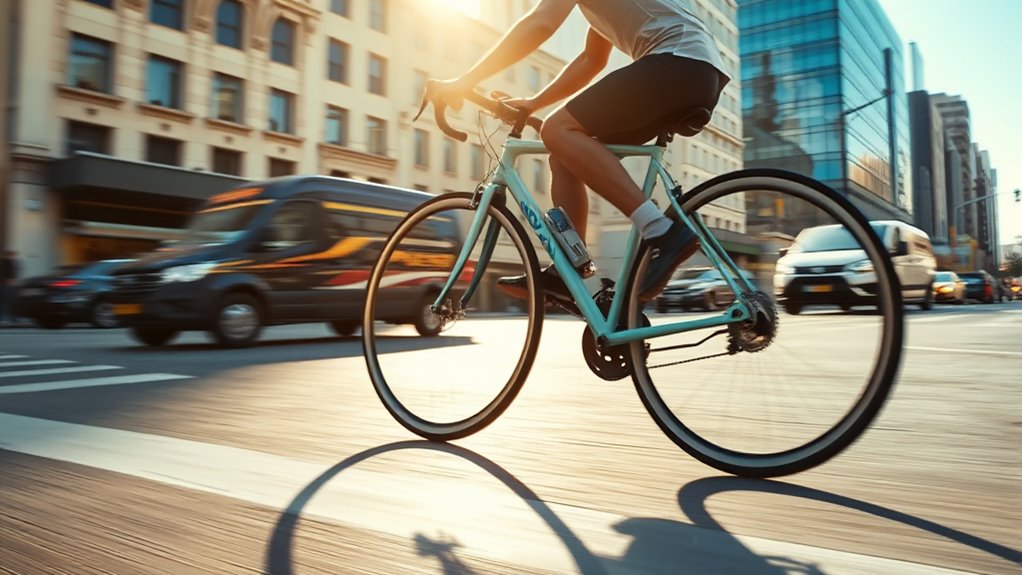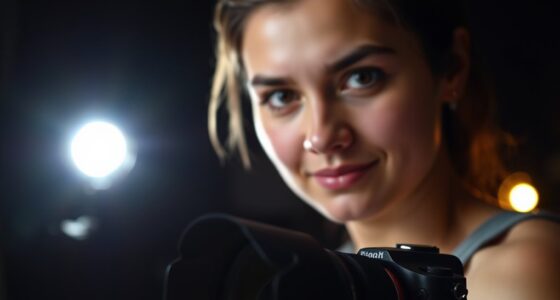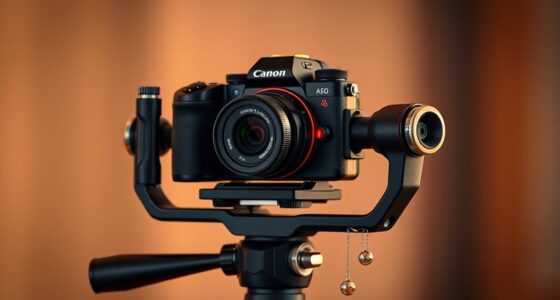To avoid rolling shutter effects, understand how your camera’s sensor captures images sequentially, not all at once. Use faster shutter speeds and lower ISO settings to reduce motion blur and distortions. Keep your movements smooth and stable with gimbals or tripods, especially during quick motions. Consider post-processing corrections if needed. Investing in equipment like stabilizers and ND filters also helps. If you want to learn more, you’ll discover effective tips and techniques for smoother shots and better footage.
Key Takeaways
- Use cameras with global shutter sensors instead of rolling shutter to eliminate readout delays.
- Increase shutter speed and reduce ISO to decrease exposure time and minimize motion artifacts.
- Stabilize your camera with gimbals or tripods to reduce rapid movements causing skew.
- Shoot in good lighting conditions to allow for faster shutter speeds without underexposure.
- Apply post-processing stabilization and correction tools to fix residual rolling shutter distortions.
Understanding the Mechanics of Rolling Shutter
Understanding how rolling shutter works is key to avoiding its distortions. It operates based on sensor design, where each row of pixels captures the scene sequentially rather than all at once. This sequential readout creates a time lag across the image, which can cause distortions with fast-moving subjects or quick camera movements. Many cameras rely on an electronic shutter to control exposure timing, replacing mechanical parts and enabling faster capture. The electronic shutter activates row-by-row, making timing differences more pronounced during rapid motion. Recognizing this process helps you understand why objects may appear skewed or wobbly in your photos and videos. Additionally, being aware of sensor design can help you choose equipment better suited to your photography needs. By grasping the mechanics behind sensor design and electronic shutter operation, you can better anticipate situations where rolling shutter artifacts are likely to occur.
Choosing the Right Camera Settings to Minimize Distortion

To reduce rolling shutter distortions, you should carefully select your camera settings, especially those related to exposure and readout speed. Lowering sensor sensitivity (ISO) can help, as a higher ISO may require longer exposure times, increasing distortion risk. Use faster shutter speeds to minimize motion blur and rolling shutter effects. Additionally, choose autofocus modes that lock focus quickly and stay stable during movement, reducing the chance of focus hunting that can cause additional distortion. Adjusting these settings ensures your camera captures fast-moving scenes more accurately. Keep in mind that some cameras have faster sensor readout speeds, which naturally diminish rolling shutter effects. By optimizing exposure times, sensor sensitivity, and autofocus modes, you can considerably reduce distortion and achieve clearer, more stable images and videos. Paying attention to sensor readout speed can significantly impact the extent of rolling shutter distortion during high-speed recordings.
Techniques for Shooting Smooth Fast-Moving Scenes
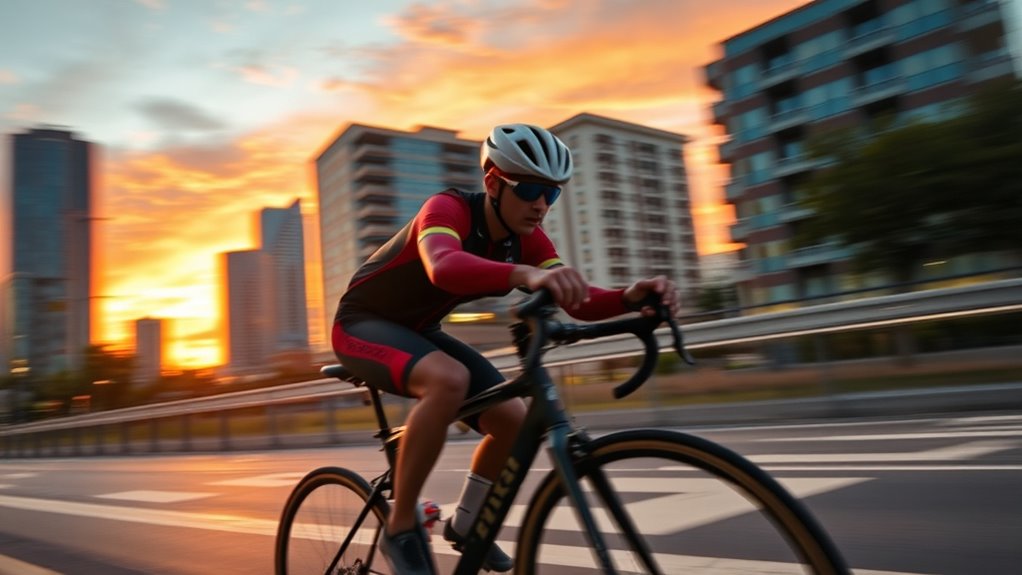
Once you’ve optimized your camera settings to minimize distortion, mastering techniques for capturing smooth footage of fast-moving scenes becomes essential. Prioritize good camera ergonomics by securely holding your camera or using stabilizers to reduce shake, which can worsen rolling shutter effects. Keep your movements deliberate and smooth, avoiding sudden jerks that can introduce distortion. Use lighting techniques like consistent, bright illumination to ensure proper exposure at higher shutter speeds, reducing motion blur and jitter. Frame your shots with a steady hand or tripod when possible, and anticipate fast action to pan smoothly rather than abrupt movements. Additionally, understanding the high-pressure application capabilities of airless paint sprayers can help you achieve a more uniform finish with fewer coats, which parallels the importance of controlled, deliberate camera movements for professional-quality footage. These approaches help maintain stability, minimize rolling shutter artifacts, and produce fluid, professional-looking footage even during rapid motion.
Post-Processing Tips to Correct Rolling Shutter Artifacts

When you notice rolling shutter artifacts in your footage, post-processing offers effective ways to rectify them. Start by analyzing the sensor readout patterns; some editing tools can compensate for skew caused by uneven sensor readout. Next, utilize software with advanced image stabilization features, which can reduce jitter and wobble resulting from rolling shutter distortions. Finally, consider applying warp stabilization or rolling shutter correction plugins designed specifically for this issue. These tools analyze the footage frame-by-frame, minimizing distortions caused by sensor readout delays. Additionally, understanding the contrast ratio can help you optimize your footage’s dynamic range and improve overall image quality during correction processes. Remember, while post-processing can improve footage, understanding the sensor readout process helps you choose the best settings initially. Combining these techniques ensures your footage looks smoother and more professional, even if some artifacts slip through during filming.
Equipment and Accessories That Help Reduce Rolling Shutter Effects
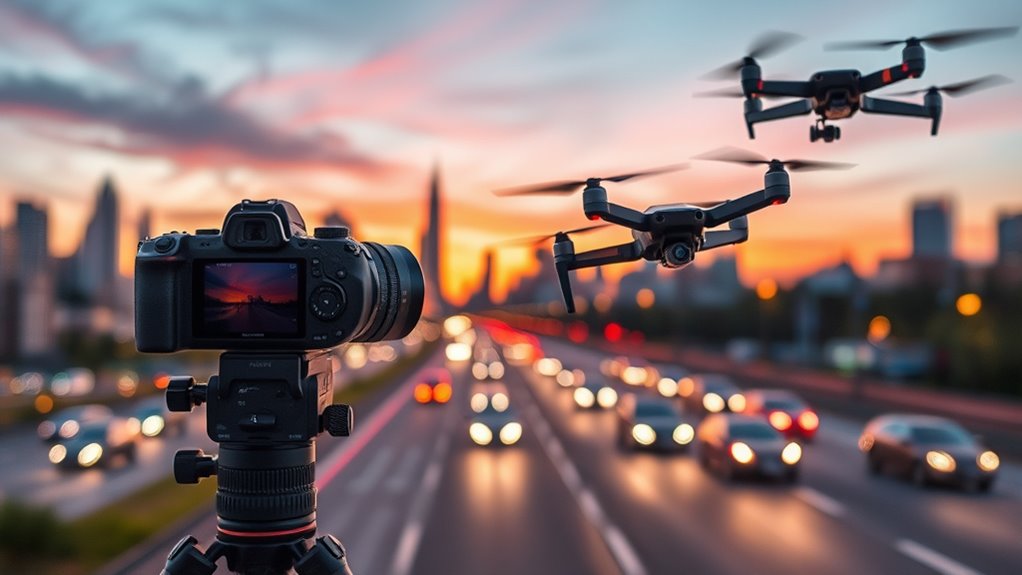
Using the right equipment can substantially reduce rolling shutter effects during filming. Gimbal stabilizers help by keeping your camera steady, minimizing rapid movements that exacerbate rolling shutter artifacts. They provide smooth footage even when you’re moving quickly, reducing the distortion caused by fast pans or tilts. ND filters are another essential accessory; they limit the amount of light entering your lens, allowing you to shoot at slower shutter speeds without overexposing. Slower shutter speeds help prevent rolling shutter distortions during fast motion or quick camera movements. Combining stabilizers with ND filters ensures your footage remains stable and clear, minimizing the rolling shutter effect. Investing in these accessories can make a significant difference, especially in dynamic shooting environments or when working with cameras prone to rolling shutter artifacts. Understanding different camera types and their susceptibility to rolling shutter issues can further help you choose the right equipment for your needs.
Frequently Asked Questions
Can Smartphone Cameras Effectively Reduce Rolling Shutter Artifacts?
Smartphone cameras can effectively reduce rolling shutter artifacts, especially if they feature a larger sensor size and advanced image processing. Brands like Apple and Samsung incorporate optical and electronic stabilization, which helps minimize distortion during quick movements. While smaller sensors in smartphones may still struggle with severe rolling shutter effects, choosing models with larger sensors and high-quality lenses markedly improves your chances of capturing smooth, artifact-free photos and videos.
How Does Sensor Size Influence Rolling Shutter Severity?
Think of your camera sensor as a garden plot—bigger plots grow more robust, just like larger sensors enhance image quality. A larger sensor size reduces rolling shutter severity by capturing more light quickly, minimizing distortions during fast movements. Smaller sensors, akin to tiny garden patches, struggle to keep up, leading to more noticeable rolling shutter artifacts. So, if you want better image quality with less distortion, opt for a camera with a larger sensor size.
Are There Any Specific Brands Known for Minimal Rolling Shutter Issues?
You’ll find that brands like Sony and Canon are known for their minimal rolling shutter issues due to advanced sensor technology and image processing. These manufacturers invest heavily in designing sensors that reduce distortions during fast motion. When choosing a camera, look for models with fast readout speeds and superior image processing capabilities, as these features markedly cut down rolling shutter effects and give you smoother, more accurate footage.
Does Shooting in RAW Format Help Mitigate Rolling Shutter Effects?
Shooting in RAW doesn’t directly reduce rolling shutter effects because it mainly affects image processing and data quality. The sensor readout speed is what influences rolling shutter; a faster readout minimizes distortions. While RAW captures more data, it’s your camera’s sensor and readout speed that truly help mitigate rolling shutter, not the file format. So, choose cameras with quick sensor readout for better results.
Can External Stabilizers or Gimbals Eliminate Rolling Shutter Distortion?
Think of a gimbal stabilization as a magic wand that can smooth out your shaky footage, but it can’t completely erase rolling shutter distortion. External hardware like gimbals helps reduce the effects by stabilizing the camera, yet fast movements still cause some distortions. To minimize rolling shutter, combine gimbal stabilization with careful camera handling and slow, deliberate movements. Remember, no device is a silver bullet, but they do help keep your shots steady.
Conclusion
By understanding how rolling shutter works and applying the right techniques, you can capture smoother footage and avoid unwanted distortions. Sometimes, the smallest adjustments—like camera settings or accessories—make the biggest difference. Remember, in photography and videography, what you think is a coincidence can often be the key to perfect shots. Stay curious, experiment, and let these insights guide you toward mastering your craft. After all, every frame holds a moment waiting to be revealed.

